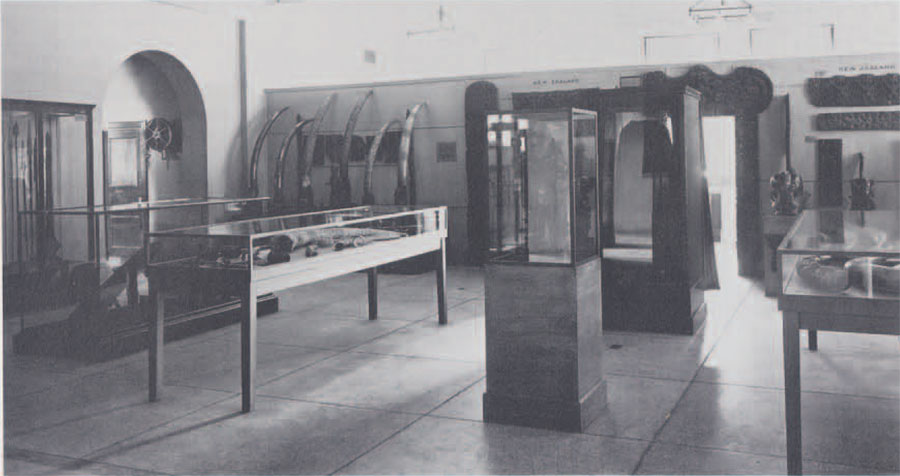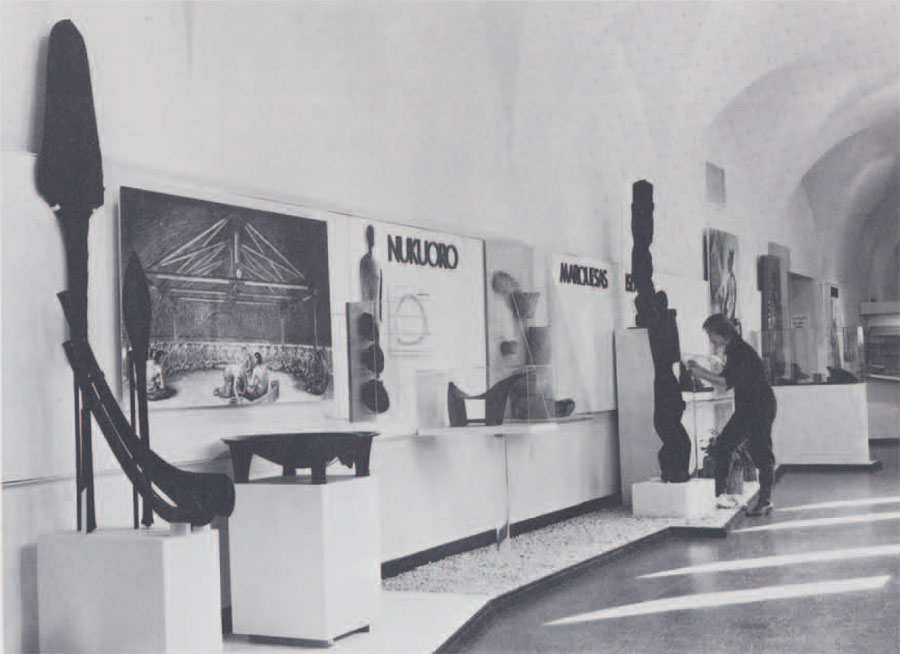
On January 28th the Museum will open a new permanent exhibition called “Polynesia.” The new exhibition replaces one called “Oceania,” which was installed nearly twenty years ago and presented objects from all three of the cultural regions of the Pacific Ocean—Melanesia, Micronesia and Polynesia—selected for their aesthetic merit. “Polynesia” represents a change of emphasis: we are focusing on only one cultural region, but we are including a much wider range of material so that both the aesthetic and utilitarian aspects of Polynesian material culture are represented: and we are including a brief summary of the archaeology of Polynesia, one of the last regions of the world to be occupied by mankind.
The University Museum has superb collections from all over the Pacific, Australia, and many islands of southeast Asia. All are under the curatorial care of the Oceanian Section. We decided to present the Polynesian region alone in the new exhibition for several reasons. Material from old Polynesia is relatively rare, yet the Museum has comprehensive collections, many of which have not been exhibited before. Also, Polynesia has a special significance for the United States, because Hawaii, our fiftieth state, is one of the major Polynesian island groups and American Samoa, one of our very few political dependencies, is comprised of islands in another important Polynesian archipelago.
From the very beginning of our Museum there was ethnological interest in the peoples and cultures of the Pacific region, and a special interest in the Polynesians, because during the 19th century they were thought to be prime examples of uncivilized men living in a “state of nature,” or what is more familiarly referred to as the Noble Savage.” These now outmoded conceptions were derived from the philosophical speculations of Jean-Jacques Rousseau and seemed to be reinforced by the discoveries in the late 18th century by such great Pacific explorers as Captain James Cook and John Francis Galaup de la Pérouse.
Thus, the Museum was begun with a pail of complementary concerns: one in the origins of civilizations, the other in the so-called non-civilized cultures. These have come to be the Museum’s “great” tradition of archaeology and “little” tradition of ethnology. The “little” tradition was very well represented in the founding collections. One of the most important of these came in 1891 from Professor Edward D. Cope, the famous palaeontologist at the University who had supported the idea of a museum. Part of his collection consisted of artifacts collected in Polynesia in 1870 by a professional field collector, This is the nucleus around which our great Polynesian collections were built and came under the care of William H. Furness 3rd, the first Curator of General Ethnology.
In the early days the Museum obtained collections in a variety of ways. For example, in 1893 Mr. Stewart Culin, then the Secretary of the Museum, purchased objects at the World’s Columbian Exposition in Chicago. Among them were many fine objects from Polynesian New Zealand. One of the most impressive was a sculptured doorway that had been carved at the Exposition by expert New Zealand Maori craftsmen who had been brought to Chicago to demonstrate the old, and justifiably famous, Polynesian skills. Later, Mr. Culin learned of some Hawaiians who were seamen on a ship docked in Philadelphia, and he invited them to come to the Museum and fabricate some artifacts from local materials.
A truly great opportunity presented itself in 1911 when Mr. W. 0. Oldman of England, the greatest collector ever of Polynesiana, decided to thin out his vast accumulation of artifacts. The Museum purchased as much as it could afford, and with these additions our Polynesian collections became notable, In 1914 another opportunity came when materials collected by Robert Louis Stevenson came up for auction in New York City. The Museum found a donor to purchase some of them.
In 1916 Mr. Henry Usher Hall, an American who had trained at Oxford, was appointed Curator of General Ethnology which included both the Pacific and African collections. Unfortunately, Mr. Hall had to leave the Museum during the Great Depression. Meanwhile, in 1929 Dr. Daniel 5, Davidson, a cultural anthropologist on the faculty of the University of Pennsylvania, stopped in Fiji on his way to Australia for two years of field research and made significant collections which eventually came to us. Dr. Davidson’s Fijian materials were the first additions to our Polynesian collections that were collected in the field by a fully trained anthropologist. From the departure of Mr, Hall until the appointment of myself as Curator in 1963 the Pacific collections were expertly managed by Miss Geraldine Bruckner, our former Registrar, advised by Dr. Ward H. Goodenough, of the Anthropology Department, who was appointed Assistant Curator of General Ethnology in 1950.
Between 1930 and 1936 the Academy of Natural Sciences of Philadelphia transferred to us, on permanent loan, all of its ethnological holdings. Among them was a collection made in Polynesia by Mr. Titian Ramsay Peale, the son of portraitist Charles Wilson Peale. In addition to being an artist, Charles W. Peale was a naturalist, and before the War of Independence he had established a private museum of natural history. The Peale Museum was the first museum of its kind in this country. Titian Peale also became an artist/naturalist, worked in the family museum, and went as a naturalist on two exploring expeditions. The one that is important for us is the United States Exploring Expedition under the command of Commodore Charles Wilkes, U.S.N. which cruised Pacific islands during the years 1835-42. It had been arranged that the natural history specimens collected on the Wilkes Expedition would be received by the Peale Museum in Philadelphia on behalf of the U.S. Government, for the Smithsonian Institution at this time existed only as a name. Most of the ethnological specimens from the Wilkes Expedition were lost in a shipwreck, but some did arrive and were catalogued at the Peale Museum. About this time, however, the Peale Museum collections were sold to P. T. Barnum in New York City. Barnum’s New York museum burned and all collections were destroyed. The materials collected by Titian Peale, however, had remained in Philadelphia, but were never taken by the U.S. Government. Eventually they went to the American Philosophical Society, which had always supported the Peales and their museum, and from there they went to the Academy of Natural Sciences, which in turn gave them to us. These items are not only the earliest ethnographic artifacts we have from Polynesia (although we have earlier archaeological materials) but are also of special significance because they were associated with both the first museum of natural history in the U.S. and the first major scientific voyage of exploration sent to the Pacific by the U.S. Government.

In 1945 we received another major collection on permanent loan from the Crozer Theological Seminary. This collection had been assembled over many years in the course of mission work in Tahiti and French Polynesia. Even as late as 1965 we arranged with anthropologist Vern Carroll to make a collection for us while he was doing field research on the island of Nukuoro, one of the so-called Polynesian Outliers, which is located in Micronesia. About that time, too, what had always been an area of interest to the Museum became formalized as the Oceanian Section.
All along we have acquired individual pieces, small and medium-sized collections as gifts, bequests and through purchase. Some of the donors were military officers who had served in Hawaii and Samoa, others were travelers who brought back mementos, and still others were serious collectors. Taken together these dozens of acquisitions would make a fine collection of Polynesian materials by themselves, but when combined with the other collections mentioned earlier, they add up to one of the finest assemblages of its kind in the world.
In the new “Polynesia” gallery are objects from all of the sources I have mentioned. Since only a small fraction of our Polynesian material culture will be included in the exhibition, we hope to keep it fresh by rotating objects from our ample reserves. I think you will be surprised, and we hope pleased, at the concept and design of the exhibition.
